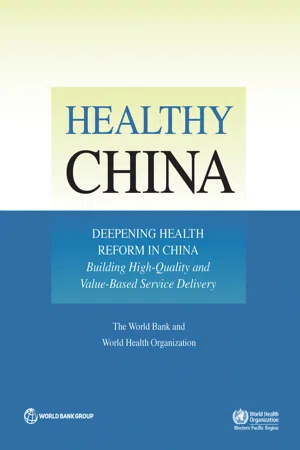
- English
- PDF
- Available on iOS & Android
About This Book
The report recommends that China maintain the goal and direction of its healthcare reform, and continue the shift from its current hospital-centric model that rewards volume and sales, to one that is centered on primary care, focused on improving the quality of basic health services, and delivers high-quality, cost-effective health services. With 20 commissioned background studies, more than 30 case studies, visits to 21 provinces in China, the report proposes practical, concrete steps toward a value-based integrated service model of healthcare financing and delivery, including: 1) Creating a new model of people-centered quality integrated health care that strengthens primary care as the core of the health system. This new care model is organized around the health needs of individuals and families and is integrated with higher level care and social services. 2) Continuously improve health care quality, establish an effective coordination mechanism, and actively engage all stakeholders and professional bodies to oversee improvements in quality and performance. 3) Empowering patients with knowledge and understanding of health services, so that there is more trust in the system and patients are actively engaged in their healthcare decisions. 4) Reforming public hospitals, so that they focus on complicated cases and delegate routine care to primary-care providers. 5) Changing incentives for providers, so they are rewarded for good patient health outcomes instead of the number of medical procedures used or drugs sold. 6) Boosting the status of the health workforce, especially primary-care providers, so they are better paid and supported to ensure a competent health workforce aligned with the new delivery system. 7) Allowing qualified private health providers to deliver cost-effective services and compete on a level playing field with the public sector, with the right regulatory oversight, and 8) Prioritizing public investments according to the burden of disease, where people live, and the kind of care people need on a daily basis.
Frequently asked questions
Information
Table of contents
- Front Cover
- Contents
- Preface
- Acknowledgments
- Abbreviations
- Executive Summary
- Introduction
- 1 Impressive Gains, Looming Challenges
- 2 Lever 1: Shaping Tiered Health Care Delivery with People-Centered Integrated Care
- 3 Lever 2: Improving Quality of Care
- 4 Lever 3: Engaging Citizens in Support of the PCIC Model
- 5 Lever 4: Reforming Public Hospital Governance and Management
- 6 Lever 5: Realigning Incentives in Purchasing and Provider Payment
- 7 Lever 6: Strengthening the Health Workforce
- 8 Lever 7: Strengthening Private Sector Engagement in Health Service Delivery
- 9 Lever 8: Modernizing Health Service Planning to Guide Investment
- 10 Strengthening the Implementation of Health Service Delivery Reform
- Appendix A Supplementary Tables
- Boxes
- Figures
- Tables